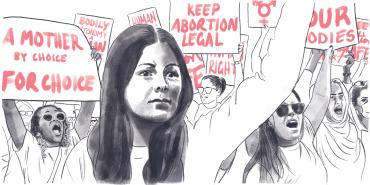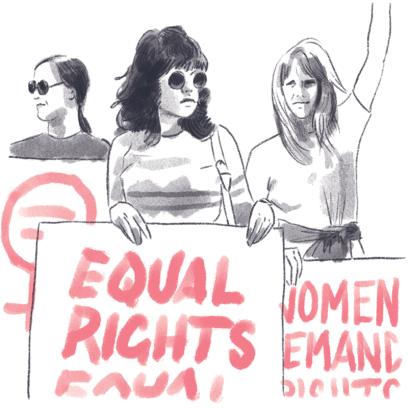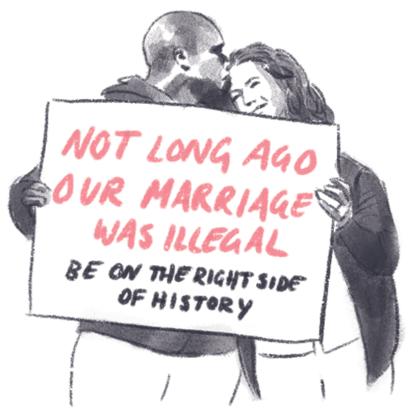In 1973, the Supreme Court held in Roe v. Wade that the Constitution protects a fundamental right to terminate a pregnancy. Seven justices—including five appointed by Republican presidents—joined the majority opinion. Only two justices disagreed with the majority’s conclusion that the Constitution does indeed protect the right to an abortion.
Roe did not fall from the sky. In fact, the court’s holding in the case logically followed a half century of case law that had preceded it. In the 1920s, the court began to interpret the Constitution to protect the rights of individuals to be free from governmental intervention in matters involving the family. In Meyer v. Nebraska (1923) and Pierce v. Society of Sisters (1925), the court held that the Constitution protects the right of parents to educate their children in the manner that they deem fit. In Skinner v. Oklahoma (1942), the court held that the Constitution protects the right of an individual to bear children and that the government was prohibited from sterilizing persons without their consent. In Griswold v. Connecticut (1965), the court held that the Constitution protects the right of married individuals to access contraception and to avoid becoming parents. In Loving v. Virginia (1967), the court struck down Virginia’s prohibition on interracial marriage, holding that the Constitution protects the right of an individual to marry a person of a different race. In Eisenstadt v. Baird (1972), the court held that its decision in Griswold applies to unmarried persons as well, interpreting the Constitution to protect the right of all people to access contraception and to avoid parenthood (or avoid having a larger family), regardless of marital status. Thus, when the court in Roe was asked to decide whether the Constitution protected the right to an abortion, it observed that the Constitution had already been interpreted to protect the individual’s right to become a parent, to avoid parenthood, and to parent their children in the manner that they thought appropriate. In light of this, the court reasoned that the Constitution also protects a fundamental right to an abortion insofar as the abortion right was consistent with all of the other fundamental rights regarding families, and the decision whether or not to create or expand a family, that the court had already interpreted the Constitution to recognize.
In June 2022, the court released its decision in Dobbs v. Jackson Women’s Health Organization. Five justices—all appointed by Republican presidents—voted to overturn Roe, discarding close to 50 years of precedent and denigrating the logical expansion of family rights that began a century ago. Dobbs allows states to criminalize abortion or otherwise make the procedure illegal at any point during pregnancy. Approximately half of the states have done, or are on the verge of doing (as this issue of AFT Health Care goes to press), exactly that.1
Supporters of the court’s decision in Dobbs assert that it is not radical because it does not impose a nationwide ban on abortion procedures; it simply permits states to limit or ban abortion if they so desire. Political majorities in the states can now decide whether the procedure should be permitted in their state, they say.
This argument ignores the entire point of a fundamental right, which is to remove certain issues from the will of political majorities. Fundamental rights protect areas of life that are too vital to the individual and to our nation to leave to democratic processes. For example, the right to practice one’s religion is a fundamental right. This is because we do not think that a fair and just society would allow people’s ability to practice their religion to hinge on whether they can convince a majority of voters in a jurisdiction that their religion should be respected and they should be permitted to observe it. Our democracy emerges from our fundamental rights; if our democratic processes could easily alter our fundamental rights, democracy itself would be in peril. Our nation would be unrecognizable as our nation. The country would no longer be American.
Another example is instructive. As mentioned above, the court in Skinner v. Oklahoma held that the Constitution protects a fundamental right to bear a child; thus, states are prohibited from sterilizing persons without their consent. This is because the Constitution endeavors to create a fair and just society, and no such society would allow a person’s ability to become a parent to hinge on whether they can convince a majority of voters in a jurisdiction that they are worthy of parenthood. If the US permitted this, the nation would cease to be essentially American.
The same logic applies to the fundamental right to an abortion. In Roe, the court held that a fair and just society would not allow a person’s ability to terminate an unwanted pregnancy to hinge on whether they can convince a majority of voters in a jurisdiction that the individual should have the ability to control what happens to their body and to determine the trajectory of their life. The ability to avoid becoming a parent—or to avoid the birth of another child—is too consequential to leave to the whims of an electorate. In this way, Dobbs is radical because it eliminates a fundamental right and allows political majorities to determine life courses.
Who Gets to Vote?
Compounding the problem, those who support the court’s decision in Dobbs ignore that several states with Republican-controlled legislatures have been on an aggressive campaign to disenfranchise voters who would likely support abortion (and Democratic candidates in general). In 2013, the court decided Shelby County v. Holder, which effectively struck down a key provision of the Voting Rights Act of 1965.* Since then, states with histories of denying people of color the ability to vote have been actively attempting to disenfranchise not only voters of color but also poor people, young people, people with disabilities, and others who would likely support Democrats. The sundry efforts at disenfranchisement include restrictive voter ID requirements, limitations on early voting and absentee voting, the closure of polling places in neighborhoods of color, and voter roll purges.† Supporters of these restrictions on voting claim that they are necessary to prevent voter fraud. However, these supporters have never been able to provide evidence that any meaningful voter fraud is taking place—let alone at a level that warrants the disenfranchisement of large swaths of people. So the court’s decision in Dobbs returns the question of abortion’s legality not to all voters, but only to voters who have not been disenfranchised.
It is likely no coincidence that many of the states with the most restrictive abortion laws are also the states with the most restrictive voting laws.2 One set of researchers ranked Mississippi, whose 15-week abortion ban set the stage for the court’s decision in Dobbs, among the worst in terms of state-erected obstacles to casting a ballot.3 This same set of researchers ranked Texas—which rendered most abortion services unavailable in the state several months before the court released its decision in Dobbs—as the worst state in terms of obstacles to voting.4 Accordingly, we should be skeptical about whether the abortion bans and restrictions that states have passed and will pass in the future actually reflect the will of the majority of people in the state. Instead, they likely will reflect the will of the people who were able to vote in the state.
A Return to 1868?
Dobbs is a terrifying decision not only because it permits states to force their residents to give birth but also because it calls into question all the cases upon which Roe relied, as well as several cases decided after Roe. This is owed to the method of constitutional interpretation that the court uses in Dobbs. In the case, the court argues that the 14th Amendment, which is the textual home of all the above-mentioned rights concerning the family, only protects those rights that were enjoyed at the time of the amendment’s ratification—in 1868. Because abortion rights were not protected then, the court concludes that abortion rights do not enjoy constitutional protection today. This method of interpreting the Constitution is disastrous for individuals who belong to groups that were not considered full citizens or valued parts of the body politic in the mid-19th century. This, of course, includes women—who did not even have the right to vote until 50 years after the 14th Amendment was ratified. Thus, the method of constitutional interpretation employed in Dobbs removes issues that are important to women and people who are capable of pregnancy—like the ability to become pregnant and to avoid pregnancy and parenthood—from the scope of constitutional protection.
Moreover, many of the cases upon which Roe relied interpreted the Constitution to protect rights that people in 1868 did not care to protect. Skinner v. Oklahoma (1942) interpreted the Constitution to recognize the right to be free from compulsory sterilization. But in 1927, in the infamous case of Buck v. Bell, the court denied that the Constitution protects that right. Thus, Skinner v. Oklahoma—alongside the cases protecting the right to access contraception and the right to marry someone of another race—rests on shaky ground after Dobbs.
Further, Dobbs calls into question the legitimacy of several cases decided after Roe. In 2003, the court handed down Lawrence v. Texas, which prohibits states from criminally punishing LGBTQIA+ people for their sexual relationships. And in 2015, the court handed down Obergefell v. Hodges, which held that the Constitution protects the right of an individual to marry someone of the same sex. Both of these decisions are precarious after Dobbs insofar as LGBTQIA+ people enjoyed precious few rights in 1868. Indeed, LGBTQIA+ people were subjected to punishment, censure, and erasure until very recently in our nation’s history. Thus, the court’s method of constitutional interpretation in Dobbs results in a Constitution that only protects the rights of cisgender, affluent, nondisabled, native-born, white men—the group that shaped the nation’s laws in mid-19th-century America.
The damage that Dobbs inflicts cannot be undone. As noted above, about half of states either have already criminalized abortion or are expected to do so soon. People in those states will only be able to legally terminate an unwanted pregnancy if they are able to travel to states where abortion is still legal. However, those who are able to travel are the lucky ones. They are fortunate because they can afford the cost of travel. They can take time off work. They can pay for childcare while they are away from home. They do not have to hide their whereabouts from an abusive partner or parent. They do not have a physical or mental disability that makes travel difficult or impossible. They are not undocumented and unable to cross immigration checkpoints. In this way, the most unprivileged and most vulnerable among us will not be able to avoid the criminal abortion laws in their states. Many people may resort to unsafe methods of abortion. Others will be forced to give birth—despite their knowing that it is not in their best interests or the best interests of their families to bring a child into the world. Intensifying the injury is the fact that the states banning abortion also tend to have policies that are not family friendly, resulting in high rates of child poverty, maternal mortality, and teen births.5 There is no way to undo that harm.
As long as Dobbs remains the law, we are in the tragic position of needing to convince political majorities in the states that they should allow individuals to determine the content and trajectory of their lives. While it has always been important to vote, it is even more important now. On the most basic level, we have to vote for lawmakers who will protect the right to vote. Democracies in which substantial portions of the electorate are unable to vote are not democracies. Beyond that, we have to vote so that we can be part of political majorities that understand the devastating consequences of forcing birth and that refuse to compel people to continue a pregnancy against their will. While it is extremely unlikely that the court will hand down a decision in the near future that protects abortion rights, Congress has the power to pass federal legislation that prohibits states from criminalizing abortion or otherwise making the procedure inaccessible. Thus, we have to vote for senators and representatives who will support such a law.
Even more broadly, we have to vote for lawmakers who understand that the right to an abortion is just one in a bundle of rights that individuals must have in order to fully control their reproductive destinies. While we desperately need laws that protect the rights of people to avoid pregnancy and parenthood, we also need laws that protect the rights of people to become pregnant and to become parents if they so desire. People must be protected against the environmental degradation that increases the incidence of miscarriages and stillbirths;6 they must also have the healthcare that will provide them with treatment for infertility. Further, we desperately need laws that protect individuals’ rights to parent their children with dignity and in conditions that support children’s physical, mental, and emotional health. Children should be able to breathe clean air, drink uncontaminated water, live in safe and secure housing, play in unpolluted communities free from violence, be educated in well-funded schools that meet their needs, access affordable healthcare, and be cared for by families and caretakers who have all the resources that they require. A society that provides as much is one that truly values life.
Khiara M. Bridges is a professor of law at UC Berkeley School of Law. In addition to being the author of three books, she is a coeditor of the series Reproductive Justice: A New Vision for the Twenty-First Century.
*To learn more about this decision, see “One Person, One Vote” by Eric H. Holder, Jr., in the Fall 2020 issue of AFT Health Care. (return to article)
†For details on these efforts to limit voting, see “Pay Attention: Democracy Is on the Ballot.” (return to article)
Endnotes
1. “Tracking the States Where Abortion Is Now Banned,” New York Times, August 17, 2022, nytimes.com/interactive/2022/us/abortion-laws-roe-v-wade.html.
2. L. Littman, “Testimony Before the Committee on Energy, Subcommittee on Oversight and Investigations, United States House of Representatives,” July 19, 2022, energycommerce.house.gov/sites/democrats.energycommerce.house.gov/files/documents/Witness Testimony_Litman_OI_2022.07.19.pdf.
3. “The Cost of Voting,” Democracy Docket, May 11, 2021.
4. “The Cost of Voting”; for more on how Texas is purposefully limiting voting and reproductive rights, see I. Tringali and J. Kirschenbaum, “Texas’s Abortion Bans and Voter Suppression Laws Let Citizens Do ‘Dirty Work’ of Opposing Constitution,” Brennan Center, November 9, 2021.
5. E. Badger et al., “States with Abortion Bans Are Among the Least Supportive for Mothers and Children,” New York Times, July 28, 2022.
6. Committee on Obstetric Practice, “Reducing Prenatal Exposure to Toxic Environmental Agents,” American College of Obstetricians and Gynecologists Committee Opinion no. 832, July 2021.
[Illustrations by Gabriella Trujillo]



